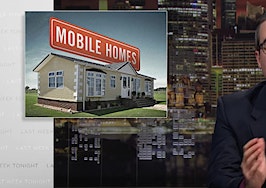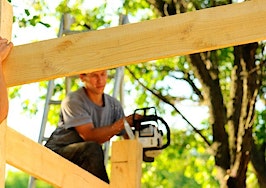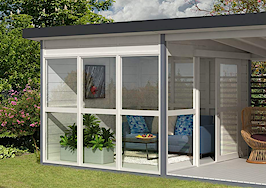When a $7,250, build-it-yourself tiny home sold out within minutes of being featured on Amazon, the head of the company that supplies it was just as surprised as anybody else. Even though Allwood Outlet is a retailer that provides a variety of different wooden products, recent demand for small cabins and tiny homes has put it at the center of a major discussion about housing options.
According to president Tapani Pekkala, the recent success of the Allwood Solvalla Studio Cabin Kit highlights just how fast the tiny home movement is moving out of the fringes — more and more people are seriously getting rid of all their stuff and moving into a home of less than 300 square feet as a way of saving money on housing.

Tapani Pekkala. Courtesy of LinkedIn.
Check out Inman’s interview about tiny homes, the downsizing movement and the state of the current housing market with Pekkala here:
What has life been like since the Allwood Solvalla Studio Cabin Kit went viral?
It’s been a pretty whirlwind ride since last week. Every once in a while we have reporters reach out about our products, but the Amazon highlight and the media coverage we received last week caused one of our cabins [the Solvalla] to sell out within minutes.
Are tiny homes a pretty large part of your product offering?
Yes. We sell them to quite a few portals such as Amazon and Home Depot but the main site is AllwoodOutlet.com.
How did you get started in this industry?
I am originally from Finland, where detached cabins and saunas are extremely popular. A friend and I were once talking about why the cabin is such an unknown thing in North America compared to the rest of the world. Australia, New Zealand and Japan are catching up fast. It was in 2012 when we finally opened our online division to try to see how a cabin kit could do here. That’s how we got started.
Are the tiny homes you sell meant as home add-ons or as one’s main residence?
They were designed in Scandinavia to work as recreational houses. We know that a number of our products have been converted for commercial purposes such as beachside cafes and other small businesses. They are useful home offices, yoga studios, art galleries due to their natural light. One lady set up a lovely chapel in Tennessee based on the Claudia model. They can have all kinds of uses but I would say that the guest house and the home office are one of the main ones we’ve been hearing about.
Recent news coverage has framed them as tiny homes, or one’s primary residence. Can or should they be used that way?
They can be used that way. There are many third-party companies selling bathroom kits [the Solvalla model doesn’t come with a bathroom] and those can be found in any Home Depot or Loewes. There’s a plethora of them online. One of our fastest-growing customer groups are Airbnb owners. We didn’t hear about any of these uses three years ago but now it’s almost massive. Three years ago, we were also hearing about people who want to buy one or maybe two units. Now, we see people who have [rented them out on] Airbnb as their primary source of income and order five and, a few months later, five more. That is something we would have never anticipated. Some even have their own building crews setting up bathrooms. Those are the people who are converting the tiny house into a whole movement. For all practical purposes, you can take a cabin of 200 square feet and make it your primary residence. People have done it.
People have been more and more interested in doing just that. Do you think that reflects the current state of the economy and the housing market?
I think that people who buy a 200-square-foot cabin are often downsizing. Even the starter home customers aim to have a little bit of room for their everyday life. But when you have a house that’s a little larger, we are talking about a product that is already overlapping with some of the usual standard homes. One person even told us, a couple of months ago, that we are a disruptor of the starter home market because of the concept. What she meant is that an owner a 100-square-foot or even a 1,000-square-foot cabin online, have it delivered and use minimum assembly for as little as $5,000. That’s quite a comparison when you look at housing prices today.
So all your tiny homes are created in a way that allows them to be put together by two adults without any contractors or builders, correct?
That is correct. One of our fundamental ideas is that you can assemble a cabin even if you’ve built virtually nothing in your life before. It’s not really building, it’s assembly. Two people can do it in a few hours but you can even make it an event. Have a party, invite your friends and turn it into a two-day project.
Were you surprised that the Solvalla was the one that sold out?
I would like to say that we knew, but the fact is that we didn’t. We had no inclination. It’s a popular model in Europe as a lake house and as an additional house that you put in your backyard but when Amazon selected it as a feature it came as a total surprise. We had no inclination whatsoever and it sold out fast. We were wondering about why we were getting this deluge of emails and ongoing phone calls until one of the media outlets contacted us and told us that it sold out in fifteen minutes. I think the combination of it being a beautiful cabin and the short assembly period helped it sell out.
Has Solvalla’s success changed your business plans for the future?
We’ve been selling cabins in the U.S. since 2012. There have been some developments, some changes of the marketplace. More people are now after our flat-roof models. What’s behind that is that there are so many movements, especially on the West Coast, where people who have big houses and backyards are incentivized to rent parts of it out. The city wants to increase its density without allocating any new land. There’s also the socioeconomic factor of it. A lot of people will live outside of cities because of the ever-increasing housing cost. Those people have long commutes. Governments want to bring people back to the cities by offering programs and affordable rents and using the land for better purposes.
UPDATE: This article has been updated to clarify Pekkala’s statements.







